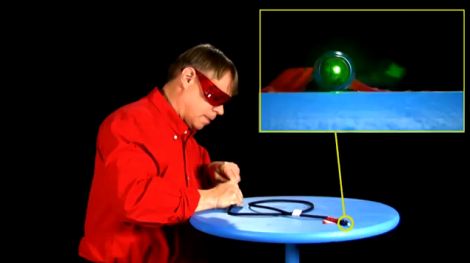
[Bill the “Engineer Guy” Hammack] is back with another lesson in the science behind the technology we know and love, but might not fully understand. This time around he discusses fiber optic cabling and how it is used to relay data across distances both small and large.
He starts off by showing how laser light can be easily transmitted from one end of an audio-grade fiber optic cable to the other. To show us how this is accomplished, he sets up a simple table top demonstration involving a bucket, some propylene glycol, and a green laser pointer. The bucket has been modified to include a clear window at one side and a spout at the other. The laser is carefully lined up, and when the spout is unplugged, a steady stream of propylene glycol is released into a second bucket. As [Bill] explains, the laser stays within the stream of fluid due to total internal reflection, and can be seen shining in the second bucket.
[Bill] also discusses how fiber optics were employed in the first transatlantic telecommunications cable, as well as how pulse code modulation was used to send analog voice data over the undersea digital link.
As always, [Bill’s] video is as entertaining as it is enlightening, so be sure to check it out below.
[youtube=http://www.youtube.com/watch?v=0MwMkBET_5I&w=470]
















http://www.rp-photonics.com/
Everything you ever wanted to know about lasers and fiber, all in one place.
Good resource for those who would like to know more..
Err.. quite basic. He didn’t even cover more robust modulation schemes or ultra-fast transforms in the light-domain. Still, thanks HaD keep them coming!
It’s nice to know how stuff works but I like to know more from where I can get some cheap fiber that I can install into my house for various purposes.
@Kris Lee:
Well, it’s not bulk fiber, but you can get a variety of optical cables at parts-express.com, and they usually have pretty good prices. 75 feet of optical cable with Toslink connectors for about $30. If you want to actually use it for anything serious I would think that would be your best bet — I’m not sure how you’d attach connectors to bulk optical fiber, but I doubt it would be as easy as with something like cat5.
Nicely done.
@MrX These videos are an intro series, meant to introduce people not in the know about the tech to technology and the engineering principles that spawned it. So various error correction and performance improvement mechanisms are a tad outside this video’s scope, I think.
I enjoy these videos and learn from them, and I feel that Bill is very good about not talking down to his audience.
For more ideas on how to use the fiber optic filaments you can visit my site and check out the fiber optic chandelier i just finished.
http://evolveelectronics.net/?page_id=451
@ kris lee
ebay is your friend. Just make sure it has a pmma core.
THAT’S ELTON JOHN!
^This
Thanks HAD, sure this stuff is basic for, I hope all of us, but the entertaining way it is shown, just perfect for the kids :-)
“Cheap fiber cable”??
“use in your house”???
“various purposes”????
I think you’d best watch All these tutorials.
Twice.
Great Vid.
I happen to have an Antennas and Optic Fibers exam this afternoon so now I’m better prepared! :-)
Nitpicking, but wasn’t the first transatlantic telecommunications cable TAT-1? saying that fiber was used in TAT-8 and calling it “the first” is a bit inaccurate. The first with fiber, perhaps.
It’s understandable that he omits so much stuff, but to suggest that your audio fiber cable is almost always made from silicon dioxide ‘pure glass’ is false and unnecessary.
This guy makes understanding complex basic scientific concepts easy for even the youngest or dumbest viewers. I like it.
Very nice examples. Keep on…
Kfir